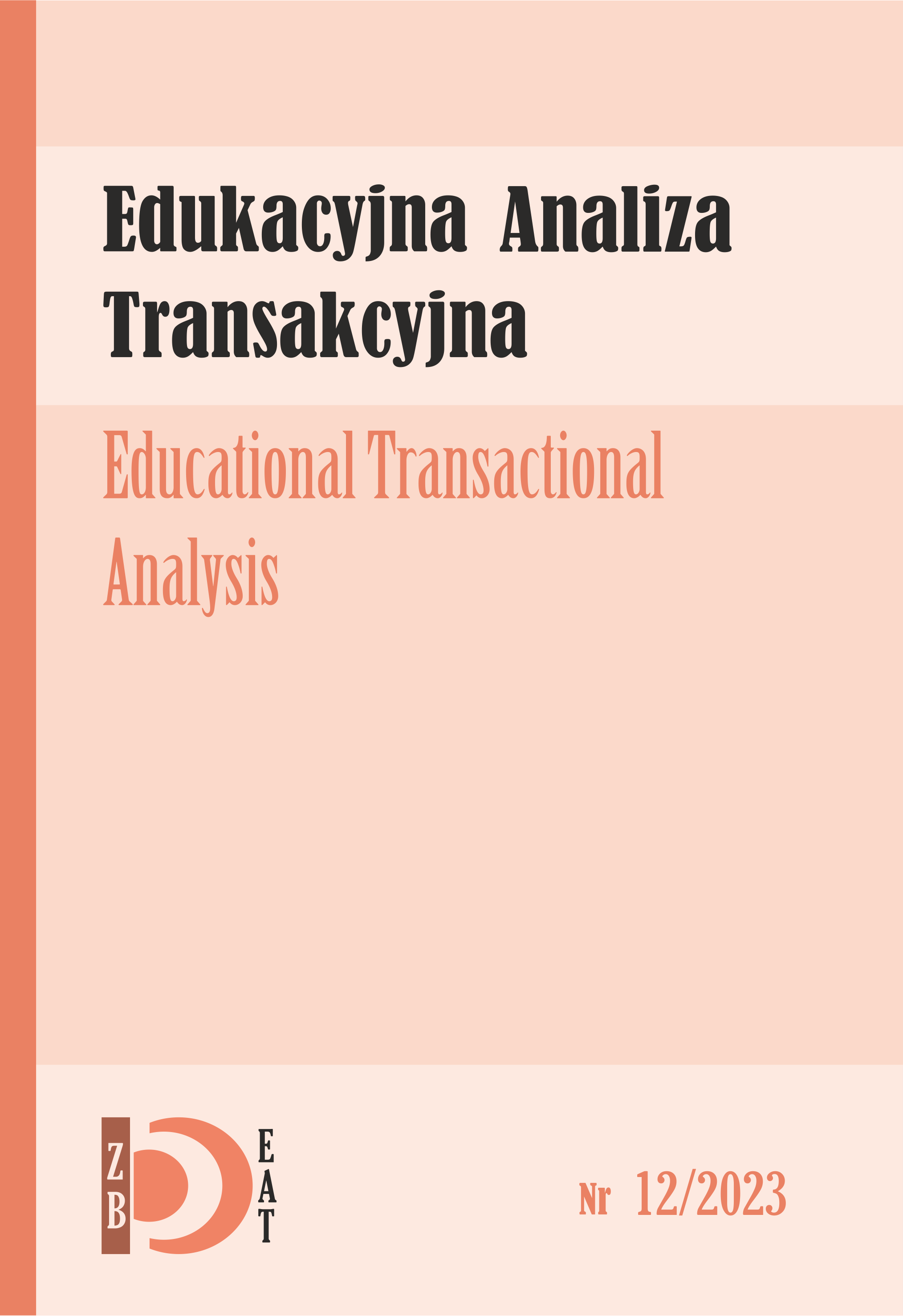The Impact of Embrace Therapy® in the Light of Transactional Analysis on the Closure of Needs ("Strokes") of the Inner Child, Changing the Perspective of Assessing the Situation and Releasing Difficult Emotions
DOI:
https://doi.org/10.16926/eat.2023.12.07Keywords:
transactional analysis, embrace therapy, inner child, biofeedback, spiritualityAbstract
The Embrace Therapy® (ET®) method is correlated with the concept of Transactional Analysis (TA), which is currently considered one of the most holistic trends in personality perception. Transactional analysis (TA), as a theory of self-states (Parent, Adult, Child), provides a coherent and simple system for defining one's own thoughts, feelings and behaviors, both in relationships with other people and with oneself. Its practical therapeutic application has to do with work and communication with the Inner Child (I-Child), which is the most primary and essential component of every personality. The ET® method combines the mental and spiritual aspects and is used to communicate with the Inner Child (ID) from the level of the Divine Parent (DP), i.e. the Spiritual Consciousness, which in the TA concept corresponds to the Adult Self. The ET® method is used to release difficult emotions such as fear, anxiety, shame, guilt, helplessness, anger, sadness, grief. The ET® method allows to release emotions about memories from the distant or near past, from the present and from imagined fears of the future, as well as changing the perspective of a given event. The empirical part of the article presents research results based on reports from brain wave recordings before and after an ET® session, which indicate a significant reduction in stress and an increase in calmness and peace in the subjects. The Biofeedback measurement method was used to study 8 volunteers. The study measured the parameters of all 8 waves (Delta, Theta, Alpha, SMR, Beta 1, Beta2, HiBeta, and Gamma) and the conclusions were drawn based on reports from these studies.
Downloads
References
Berne, E. (2022). W co grają ludzie. Psychologia stosunków międzyludzkich. Warszawa: Wydawnictwo Naukowe PWN, s. 8.
Boszormenyi-Nagy, G. M., Spark, L. (1973). Invisible loyalties: Reciprocity in Intergenerational Family Therapy. New York: Harper & Row, s. 19.
Filimon, F., Nelson, J. D., Hagler, D. J., Sereno, M. I. (2007). Human cortical representations for reaching: mirror neurons for execution, observation, and imagery. Neuroimage, 37(4), 1315-28. doi: 10.1016/j.neuroimage.2007.06.008. Epub 2007 Jun 18. PMID: 17689268; PMCID: PMC2045689.
Gambin, M., Łukowska, E. (2009). Wspomaganie rozwoju dzieci z autyzmem. Warszawa: Wydawnictwa Uniwersytetu Warszawskiego.
Henry, R. (2005). The mental Universe. Nature, 436, 29. https://doi.org/10.1038/436029a
HPM Medical (2022). Materiały szkoleniowe I stopień Trenera Biofeedbacku.
Jankowski, K. (1980). Analiza transakcyjna. W: H. Wardaszko Łyskowska (Red.), Terapia grupowa w psychiatrii. Warszawa: Państwowy Zakład Wydawnictw Lekarskich, s. 197.
Jagieła, J. (2012). Edukacyjna Analiza Transakcyjna w kilku odsłonach. Częstochowa: Akademia im. Jana Długosza w Częstochowie, s. 13. Pobrano z: http://dlibra.bg.ajd.czest.pl:8080/Content/371/Edukacyjna_Analiza_T.pdf
Jagieła, J. (2015). Stan wewnętrznego dziecka w analizie transakcyjnej. Prace naukowe Akademii im. Jana Długosza w Częstochowie. Pedagogika, XXIV, 321–330. http://dx.doi.org/10.16926/p.2015.24.26
Jastrzębski, A. (2010). Analiza transakcyjna. W: L. Grzesiuk & H. Suszek (Red.), Psychoterapia. Integracja. Podręcznik akademicki. Warszawa: ENETEIA Wydawnictwo Psychologii i Kultury, s. 360.
Leary, M. R., Springer, C., Negel, L., Ansell, E., & Evans, K. (1998). The causes, phenomenology, and consequences of hurt feelings. Journal of Personality and Social Psychology, 74(5), 1225–1237. https://doi.org/10.1037/0022-3514.74.5.1225
Luvaas, T. (1995). Jestem tutaj – rozmowa z moim wewnętrznym dzieckiem. Łódź, s. 12.
Pańczyk, J. (1998). System biofeedeback w praktyce dydaktyczno-pedagogicznej. Roczniki Pedagogiki Specjalnej, 9, 43–72.
Pecyna, M. B. (2001). Psychologia kliniczna w praktyce pedagogicznej. Warszawa: Wydawnictwo Akademickie Żak.
Schutzenberger, A. A. (2017). Psychogenealogia w praktyce. Warszawa: Wydawnictwo Virgo.
Szymańska, D. (2020). Boski Umysł. Warszawa: Wydawnictwo Virgo, s. 169.
Thompson, M. & Thomson, L. (2012). Neurofeedback. Wprowadzenie do podstawowych koncepcji psychofizjologii stosowanej. Wrocław: Wydawnictwo Biomed Neurotechnologie.
https://www.ted.com/talks/jill_bolte_taylor_my_stroke_of_insight?language=pl&subtitle=pl
Downloads
Published
How to Cite
Issue
Section
License
Copyright (c) 2023 Dagmara Szymańska

This work is licensed under a Creative Commons Attribution 4.0 International License.
I am aware that the Educational Transactional Analysis journal is published under a Creative Commons license - Attribution (https://creativecommons.org/licenses/by/4.0/legalcode).
By submitting the article, I agree to make it available under this license

